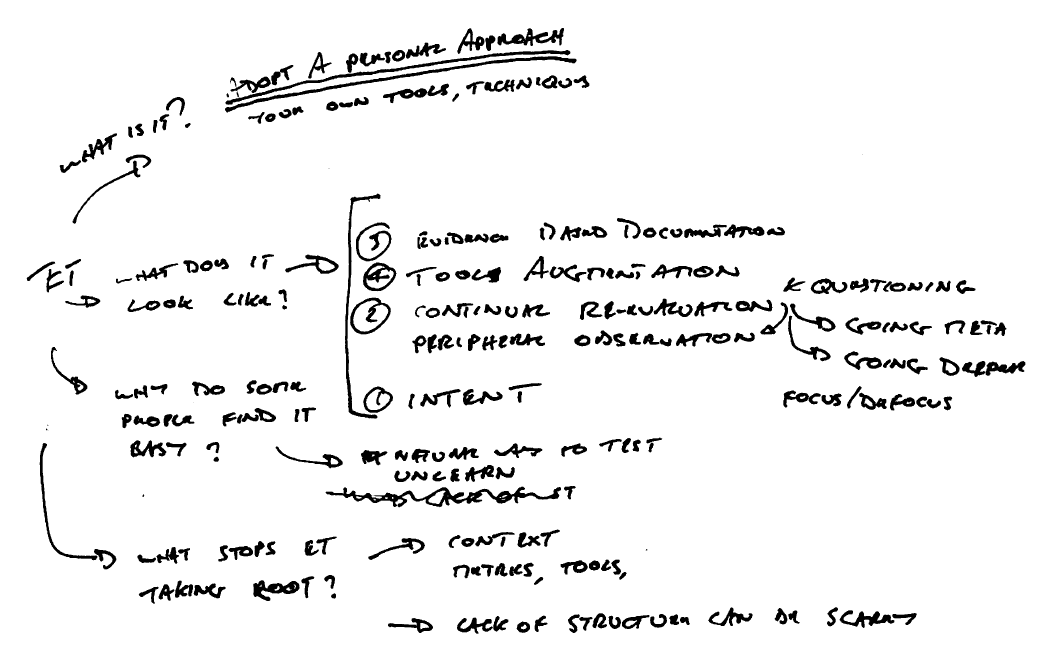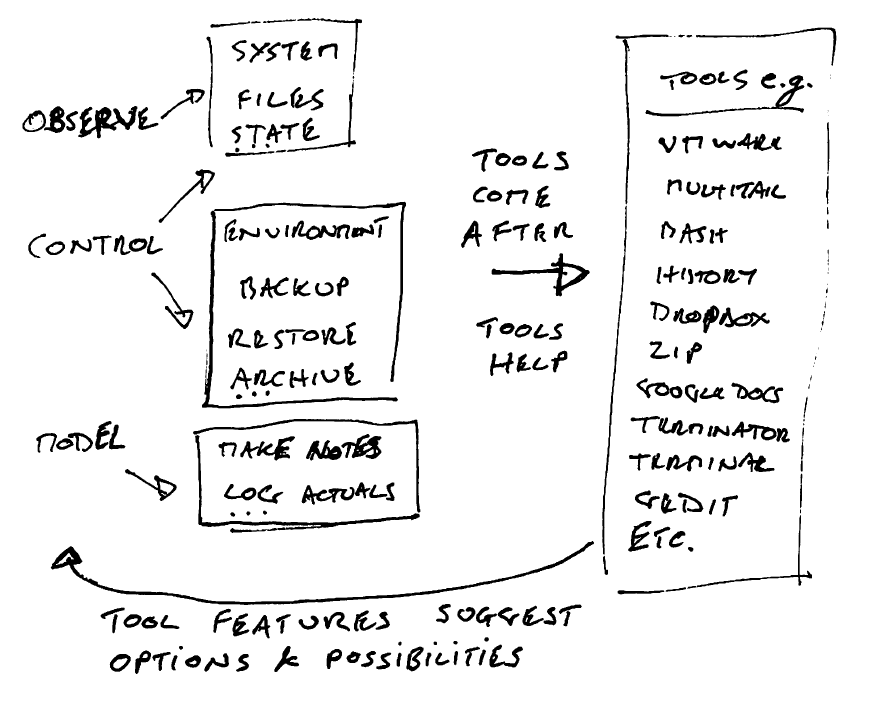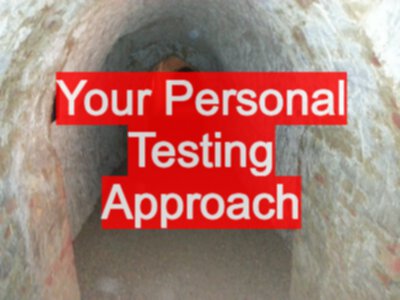Adopting a personal approach to Testing led me to adopt an exploratory approach to Testing, one driven by unique models, decisions, skills and sources of knowledge.
This post is based on a couple of diagrams I found in my notes, they are included at the end of the post.
What is Exploratory Testing?
Using models that we derive from observation and questioning to explore the item under test and map the exploration in such a way that we can communicate points of interest and importance.
- What is it?
- Adopt a personal approach
- Your own Tools, techniques
Exploratory Testing requires taking responsibility:
- what you plan to do
- what you will do next
- the level of detail in your notes
- how you communicate
- how you model what you learn
- will you investigate something in more detail or stop and move on to the next thing
- etc.
People testing may be working in an environment that is antagonistic and blaming, so they use methodology or technique application as a safety net to avoid blame. Any gaps or issues can be traced back to the methodology, techniques or standards.
Someone who is used to picking the next test case out of the test management system and executing the script, may well find the ongoing learning and decision making when exploring hard or fearful.
Someone who is used to putting a tick next to a test script step may find the making of notes and gathering of evidence as time consuming or irrelevant. Because they haven’t learned that the gathering of evidence, note taking and reflection is part of the process of building models to guide them in how to make future decisions for testing.
When we take responsibility, we build up a personal approach which we can map on to other environments, methodologies and processes. We also learn how to build our own processes based on the needs of the moment.
Tooling is chosen based on what we plan to do, and lessons learned abour our constraints and limitations as we test.
We want to be able to: Observe (and Interrogate), Control (and Manipulate), and Model the system. As we test we learn the limits of our capabilities and find tools to help us.
When we have tooling, the functionality they offer may allow us to do things we never expected and so suggest new options and possibilities, they can expand our model of what exploration opportunities are available.
Tools augment our testing, and often at a personal level because different tools require different levels of knowledge and experience to use them.
What does Exploratory Testing look like?
Building your testing around exploring starts with Intent. Where will you go? What do you seek? How will you travel, observe and map? How long will you explore for?
- What does it look like?
- Intent
- Continual Re-evaluation
- Questioning
- Peripheral Observation
- Going Meta
- Going Deeper
- Evidence Based Documentation
- Tools Augmentation
We can explore the same areas as previous explorers and vary what we look for, or how we will explore.
One key is to explore with intent. This helps keep concentration during the exploration, otherwise it is too easy to go off track and be distracted by something new and shiny. In those situations we typically mark the ’new and shiny’ in our notes to feed into a future exploration, or we might decide that given our initial observations that looks like something more important to explore and so choose to dedicate the remainder of our time to it.
The process of exploration is filled with decisions, based on what we observe and how that expands or confirms the model we are using to explore.
Exploring leaves behind a detailed log and trail of notes:
- what we planned to do
- what we did
- what we observed
- where we stored the evidence
- what questions this raised
- where, when and how we deviated from the path
- where did we go
- what did we do
- what data did we use
- ideas for future exploration
- where our observations differed from our expectations
- how long we spent in different areas
- what tooling we used to interrogate in more detail
- etc.
Why do some people find Exploratory Testing easy?
Practice. The people who make exploratory testing look easy have practiced deliberately.
- Why do some people find it easy?
- Natural Way to Test
- Unlearn
Exploring is the natural way to test anything. If you took someone off the street and asked them to ’test’ something, they would explore it. They would not start by filling in a Test Strategy Template, creating formal models and applying techniques.
They would have to learn additional skills to help track their exploratory testing, but some people are used to making comprehensive todo lists, checklists and making notes about their work. Those time management and productivity skills are a good natural building block for exploratory testing note taking.
They would also have to learn how to use specialised tooling to help them observe, interrogate and manipulate the system. These are technical skills related to the activity at hand and learning these on the job is a normal expectation.
They have learned to trust themselves rather than putting all their trust in someone else’s standard, methodology or set of techniques. They have learned to look at the essence of those trappings (standard, methodology, techniques, etc.) and use those that are appropriate at the time or serve the needs of their current exploration. They control the trappings, they are not controlled by the trappings.
They trust also in their own research and experience.
No-one starts testing with ’no knowledge’, everyone knows stuff. But… they might not know ‘what stuff’, in their existing experience and knowledge, is useful to them yet. And… they might not trust themselves to draw upon their existing knowledge, choosing instead to rely on the numerous writings of the Testing World. Learning the World of Testing is important, but takes time. We can learn the World of Testing in parallel with identifying how to harness what we already know and study.
Those people who make exploratory testing look easy, and unique, are harnessing the knowledge they have learned from other disciplines as well as the World of Testing.
If you see someone make exploratory testing look easy then they will have taken responsibility for their testing, and their ability to test.
What stops Exploratory Testing Taking Root?
Some environments impose more command and control structures than others. The environments that offer more freedom for an individual to take responsibility are those that help exploratory testing take root. It is still possible for an individual to take responsibility of their testing, perform exploration and use non-standard tooling, but this is often done out of sight of the control structure. Because it is hidden, the environment and other people on the team don’t learn from it and the tactics of the individual don’t spread.
Sometimes all it takes is for a few individuals to make their approach public, to help demonstrate what they do to make their testing effective, and others will adopt the same practices and the environment slowly changes.
- What stops ET Taking Root?
- Context
- Tools
- Metrics
- Standards
- Fear
- Lack of safety net structure can be scary: methodology, formal models, application of techniques
- Requires responsibility: what if it goes wrong? what if we miss something?
- Context
Mind Maps and Notes
Exploratory Testing Mind Map

ET
- What is it?
- Adopt a personal approach
- Your own Tools, techniques
- What does it look like?
- Intent
- Continual Re-evaluation
- Questioning
- Peripheral Observation
- Going Meta
- Going Deeper
- Evidence Based Documentation
- Tools Augmentation
- Why do some people find it easy?
- Natural Way to Test
- Unlearn
- What stops ET Taking Root?
- Context
- Tools
- Metrics
- Standards
- Fear
- Lack of safety net structure can be scary: methodology, formal models, application of techniques
- Requires responsibility: what if it goes wrong? what if we miss something?
- Context
Tooling Mind Map
We want to be able to: Observe and Interrogate, Control (Manipulate), and Model the system.
When we know what we want to do, tooling can help us do this.
When we have tooling, the functionality they offer may allow us to do things we never expected and so suggest new options and possibilities.
Tools used in this way can be selected for their fitness to the task at hand and which the individual finds works best for them.








